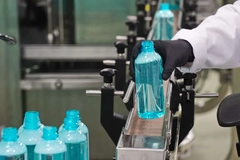Historic brand bags colorful new look
06 Nov 2011

As part of a marketing campaign highlighting 150 years of commercial pretzel baking by the Sturgis family, Tom Sturgis Pretzels (Reading, PA) refreshed its snack packaging this year with a colorful, modern look.
As part of a marketing campaign highlighting 150 years of commercial pretzel baking by the Sturgis family, Tom Sturgis Pretzels (Reading, PA) refreshed its snack packaging this year with a colorful, modern look. Because of the brand equity at stake, the company took a phased approach to the project—starting with the introduction of four premium, artisan pretzel products.
These four new products would represent the pinnacle of five generations of Sturgis family bakers’ improvements to the recipe developed by family patriarch Julius Sturgis in the 1800s. Tom Sturgis Pretzels, which is now led by Julius’ great, great grandson Bruce, was confident that its specialized knowledge would make product development a slam-dunk. The company wanted the same certainty when it came to the products’ packaging, so it partnered with design agency William Fox Munroe.
Stop, look, imagine
“They hadn’t made changes in so many years, and I was getting the sense that we needed to make a dramatic change,” Tom Newmaster, partner at William Fox Munroe, explains. “We had to get them to take a step back, look at the whole line, and really think about how that new line would look on the shelf.”
“They hadn’t made changes in so many years, and I was getting the sense that we needed to make a dramatic change,” Tom Newmaster, partner at William Fox Munroe, explains. “We had to get them to take a step back, look at the whole line, and really think about how that new line would look on the shelf.”
To get the process started, William Fox Munroe collected images of competing packaged products in various markets. This also helped introduce package concepts very different from Tom Sturgis’ current glossy, windowed packaging with its little-boy brand mark. For years, the brand’s bags have encouraged consumers to look for the Little Dutch Boy icon. Although the brand mark depicted a youthful character, this illustration was beginning to show its age.
The design agency challenged the effectiveness of the icon as a simple drawing. “We asked, ‘Does this character represent your company?’” says Newmaster. “We explained that it could be a little friendlier if we brought it into the 2000s, and we showed examples of how other characters developed over time—Chester Cheeto, Mr. Clean, and the Trix rabbit.”
The brand mark was redesigned with a more realistic look, with warm flesh tones and blond hair. He also moved to the top of the bag’s front panel and got cozy with the brand logo. “They used to handle the Tom Sturgis text logo and the icon separately,” says Newmaster. “We made it into one unit that could be used just about anywhere.”
Coloring Tom’s world
The brand mark wasn’t the only element to get a color update. Previous packaging used a solid-color background that offered shelf impact but didn’t communicate the natural ingredients inside. The new bags keep wide bands of solid color to help consumers identify flavors, but they also sport wheat-colored backgrounds behind the brand mark and logo lockup and behind the high-end product photography. The logo lockup also gained illustrations of the grain, housed in a red-and-black half circle behind the icon.
The brand mark wasn’t the only element to get a color update. Previous packaging used a solid-color background that offered shelf impact but didn’t communicate the natural ingredients inside. The new bags keep wide bands of solid color to help consumers identify flavors, but they also sport wheat-colored backgrounds behind the brand mark and logo lockup and behind the high-end product photography. The logo lockup also gained illustrations of the grain, housed in a red-and-black half circle behind the icon.
To maximize the graphic design changes, including the product photography that replaced the previous bag’s window, William Fox Munroe suggested matte-finish bags for the four new premium products. The matte film avoids harsh reflections from retail store lighting, and the packaging material also serves as a product differentiator on shelf.
“There were probably only one or two snack bags out there in a matte finish when we suggested this,” says Newmaster. Because William Fox Munroe has strong digital prototyping capabilities in house, with printers from HP, Roland, and Kodak—and because there were so few other snacks in matte bags—the agency created digital prototypes to show the client as early as the first package concept presentation. This, Newmaster says, helped the agency confirm that the client truly liked the matte bags’ look and not just the reasoning behind it. It also helps the agency catch and correct problems before designs go to production, he adds, “and that saves brand owners time and money.”
Registered results
Having manufacturing-ready designs was especially important because the bags have a complex 10-color scheme. “There’s a lot going on with different colors on these packages,” says Mike Graziano of Packaging by Design, which supplies the bag film.
Having manufacturing-ready designs was especially important because the bags have a complex 10-color scheme. “There’s a lot going on with different colors on these packages,” says Mike Graziano of Packaging by Design, which supplies the bag film.
He notes that several of the bag’s process colors are colors that the package printer typically prints using spot-color inks. To be able to print these colors in process, Graziano explains, the printing equipment needs to hold exceptional register and high-quality printing plates must be used.
The bag film is reverse-printed using water-based inks on a Keun Yuh central impression (CI) press. The advantage to using this type of CI press is that its gearless, servo-driven systems ensure good registration and print resolution even at high running speeds.
The printed matte film is then laminated to a clear polypropylene film using water-based adhesives. The water-based inks and adhesives, Graziano says, make for a more sustainable bag film than one made with traditional methods.
The converter’s manufacturing process also results in safer and stronger snack bags. The inks never touch the food because the printed surface is trapped between the film layers, and the lamination process adds strength without adding thickness to the film.
Designs on expansion
“We got such a good reception from our salespeople and our independent distributors that we decided to change all of our product line to the new design,” says Bruce Sturgis. William Fox Munroe adjusted the design to work across Tom Sturgis Pretzels’ other products, without diluting the differentiation built into the new premium products. Some lines, for example, are in matte polypropylene bags. Others are in glossy polypropylene bags, and their packages use windows to display the product instead of photography. More of Tom Sturgis Pretzels’ mainstay products will move to the new glossy polypropylene bags as existing film supply exhausts.
“We got such a good reception from our salespeople and our independent distributors that we decided to change all of our product line to the new design,” says Bruce Sturgis. William Fox Munroe adjusted the design to work across Tom Sturgis Pretzels’ other products, without diluting the differentiation built into the new premium products. Some lines, for example, are in matte polypropylene bags. Others are in glossy polypropylene bags, and their packages use windows to display the product instead of photography. More of Tom Sturgis Pretzels’ mainstay products will move to the new glossy polypropylene bags as existing film supply exhausts.
With about 75 percent of the product line in the newly designed bags, Sturgis says that it’s too early to tell if the package redesign alone is responsible for recent sales increases. But the 150-year-anniversary marketing campaign that the package design is part of has been a huge success.
The marketing campaign response puts a smile on Sturgis’ face not only because it increased sales. It also shows that more people are getting Tom Sturgis Pretzels’ most important brand communication: “It’s a super thank-you for all the business over the years.”
Source: Tom Sturgis Pretzels
All content and features on this website are copyrighted with all rights reserved. The full details can be found in our privacy statement
Subscribe to our newsletters
By continuing to browse our site you agree to our Privacy Statement











